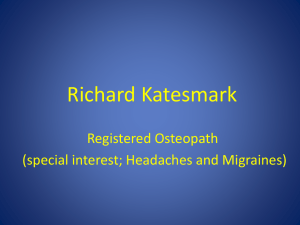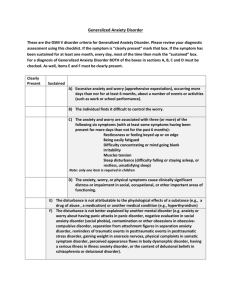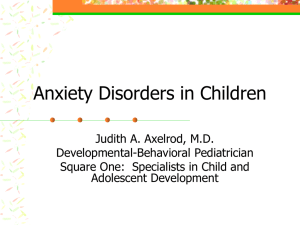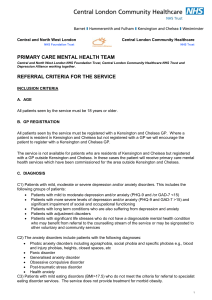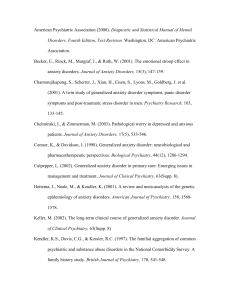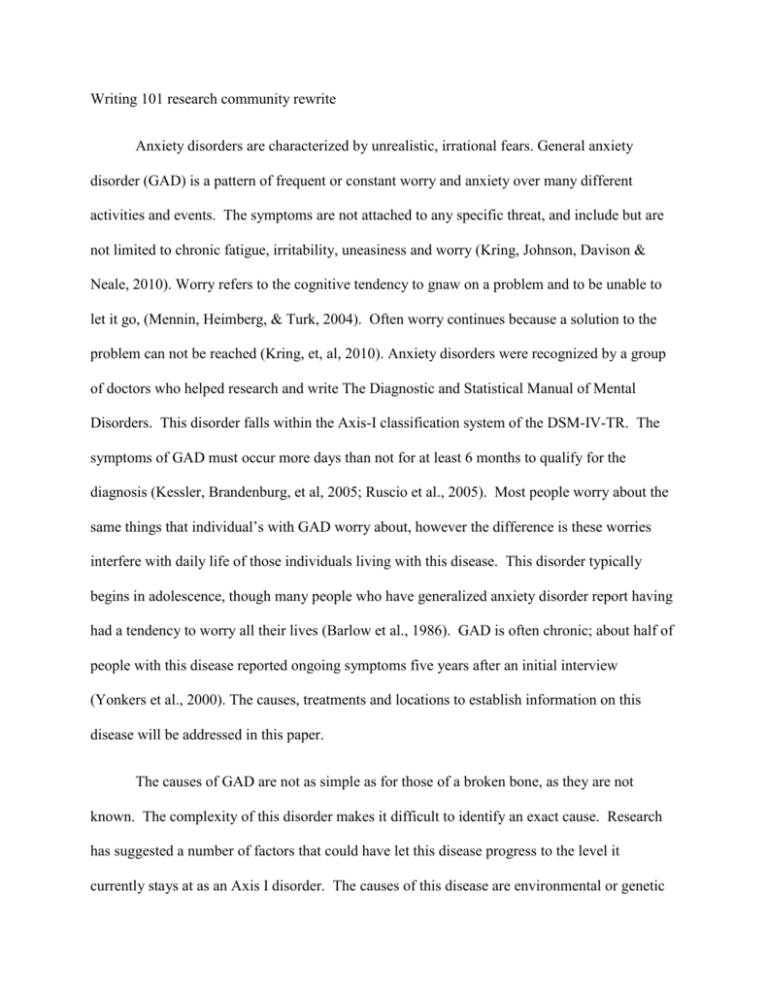
Writing 101 research community rewrite
Anxiety disorders are characterized by unrealistic, irrational fears. General anxiety
disorder (GAD) is a pattern of frequent or constant worry and anxiety over many different
activities and events. The symptoms are not attached to any specific threat, and include but are
not limited to chronic fatigue, irritability, uneasiness and worry (Kring, Johnson, Davison &
Neale, 2010). Worry refers to the cognitive tendency to gnaw on a problem and to be unable to
let it go, (Mennin, Heimberg, & Turk, 2004). Often worry continues because a solution to the
problem can not be reached (Kring, et, al, 2010). Anxiety disorders were recognized by a group
of doctors who helped research and write The Diagnostic and Statistical Manual of Mental
Disorders. This disorder falls within the Axis-I classification system of the DSM-IV-TR. The
symptoms of GAD must occur more days than not for at least 6 months to qualify for the
diagnosis (Kessler, Brandenburg, et al, 2005; Ruscio et al., 2005). Most people worry about the
same things that individual’s with GAD worry about, however the difference is these worries
interfere with daily life of those individuals living with this disease. This disorder typically
begins in adolescence, though many people who have generalized anxiety disorder report having
had a tendency to worry all their lives (Barlow et al., 1986). GAD is often chronic; about half of
people with this disease reported ongoing symptoms five years after an initial interview
(Yonkers et al., 2000). The causes, treatments and locations to establish information on this
disease will be addressed in this paper.
The causes of GAD are not as simple as for those of a broken bone, as they are not
known. The complexity of this disorder makes it difficult to identify an exact cause. Research
has suggested a number of factors that could have let this disease progress to the level it
currently stays at as an Axis I disorder. The causes of this disease are environmental or genetic
factors, while it could be argued that it could be both simultaneously. This disease may be
heritable, according to the Anxiety Disorders Association of America; more than 5 out of every
100 people will develop GAD at some point in their lives as a result of biological factors, family
background and life experiences. Individuals may be predisposed to developing the symptoms of
GAD. While Generalized Anxiety Disorder may be due to an imbalance of certain chemicals in
the brain such as dopamine and serotonin, which affect and regulate our moods and behavior,
when these chemicals are imbalanced, they may lead to symptoms of GAD.
Treatment consists of pharmacotherapy and various forms of psychotherapy. The
benzodiazepines are used for short-term treatment, but because of the frequently chronic nature
of generalized anxiety disorder, they may need to be continued for months to years. Buspirone
and antidepressants are also used for the pharmacologic management of patients with generalized
anxiety disorder. Patients must receive an appropriate pharmacologic trial with dosage titrated to
optimal levels as judged by the control of symptoms and the tolerance of side effects. Psychiatric
consultation should be considered for patients who do not respond to an appropriate trial of
pharmacotherapy. (Am Fam Physician 2000;62:1591-600,1602.) (American Psychiatric
Association, 1994). The sections of this chapter address the following topics: Effective
treatments for generalized anxiety disorder; Efficacy of cognitive-behavioral therapy for
generalized anxiety disorder; Factors that lead to poor treatment response; and Case example.
(PsycINFO Database Record (c) 2009 APA, all rights reserved) These journals and on-line
locations are great resources. Additionally there are several conferences on this disorder across
America. The Anxiety Disorders Association of American is the non-profit organization in
America that holds annual conferences. The Anxiety Disorders Association of America
(ADAA) is a national nonprofit organization dedicated to the prevention, treatment, and cure of
anxiety disorders and to improving the lives of all people who suffer from them.
REFERENCES
1. American Psychiatric Association. Diagnostic and statistical manual of mental disorders,
4th ed. Washington, DC: American Psychiatric Association, 1994.
2. (Am Fam Physician 2000;62:1591-600,1602.)
3. Kring, Johnson, Davison & Neale, 2010).
4. (PsycINFO Database Record (c) 2009 APA, all rights reserved)




